Report of the funeral of private A.H.W. Harrison, May 9th 1945
The Dutch Foundation Memorial 2015 for Dam victims 7 May 1945 researches the victims of the Dam shooting in Amsterdam. During their research in the Archives for information about victims, the document below was found at the Amsterdam Archive, the Council Office for Funeral Services. It isn’t in relation to May 7th 1945 and the shootings at the Dam Square, but is about the death of an English soldier on May 8th 1945 during a motorcycle accident in the Dutch capital.
Amsterdam May 9 1945.
The funeral of the English soldier A.H.W. Harrison
Born January 12 1926 – Died May 8 1945
May 8 1945. Amsterdam is celebrating. Holland is liberated. The first Canadian troops entered Amsterdam yesterday. They were greeted with acclaim by the Amsterdam citizens. Passing rows of people with flags they entered in their small and large army trucks. They were all very happy. Sadly, many of their fellow combatants had died in their fight for our freedom, but they had survived and could be part of the big parade.
Among them was the English soldier, AHW Harrison, who was attached to the Canadian troops, who camped in the Amsterdam Stadium at the Amstelveenseweg. Harrison was excited too. After all, his task of liberation was accomplished. Very soon he would cross the sea, home to his beloved England.
Unfortunately it was not to be. A fatal accident ended a brave young life. On May 8 1945 he drove his motorcycle against a stone barricade of our common German enemy and died almost immediately.
On Wednesday May 9 1945, at about 1030 hours, a Padre (a Canadian Reverend), an officer and the Dutch journalist Reens came to our office and asked for assistance with the funeral of Harrison.
Mr Reens said that they wanted to bury Harrison temporarily in the Amsterdam Stadium, but he thought it better if it could be done at a cemetery – otherwise people would be walking over the grave and that was not respectful.
The Padre claimed that this was the way it was done in war and that in most cases it could not be done in any other way. However, if it was possible for Harrison to be buried at a cemetery it would be most appreciated by the Reverend. While Mr Feltkamp [head of the Council Office for Funeral Services] was at the Registry Office I took charge of what was needed.
The Canadian Commander wanted to bury Harrison at the nearest cemetery as soon as possible. This was Buitenveldert, so I phoned the person in charge of the cemetery; we got permission to come at once. I informed the Padre and asked if I should organise a coffin. This was not the tradition – Harrison should be buried in the English Flag without a coffin.
The Padre admired the roses at Mr Feltkamp’s desk and asked for one from Miss Hooijmeijer; because he liked them so much, he was given the whole bunch and promised to put them in water as soon as he arrived home. In order to give them my full cooperation I mentioned that I was available to come with them to the funeral, and this was accepted gratefully.
We left at 1100 hours for the Stadium. At the stairs of the Registry Office we met two men with a very large soup pot full of erwtensoep [pea soup]. The Reverend insisted that he wanted to look at it, and this was permitted. He then wanted to taste some of it. The lady from the kitchen arrived with a plate and spoon. "No, no, no, only a spoon" but she gave him the plate. I said that he meant the spoon. He tasted a spoonful of pea soup and his comment: "Not good" was followed by a big cheer from the officials present.
After saying goodbye to the people, we drove to the Stadium in the car which stood ready in front of the office. I wanted to stand on the back of the truck, but the Padre wanted me in the cabin. Afterwards he told me that he had appreciated this, as he had the opportunity to see the Amsterdam people and the decorations. He was very pleased that I had gone along with his request.
In the stadium Harrison, in his uniform, was put on a catafalque covered with a blanket. I acknowledged him respectfully. The catafalque was put on the truck and the Reverend and 10 Canadians took up position on both sides. The chauffeur, the journalist and I took our places in the cabin and the sad procession drove slowly to the cemetery "Buitenveldert".
The public noticed immediately what was happening and respectfully removed their hats and caps.
At the cemetery we were greeted by board member Mr van der Sluis. I told him that it would be highly appreciated if the Duty Chaplain could be present. He was immediately invited and mentioned that he very much wanted to be present. Under the supervision of Mr van der Sluis, assisted by four Canadians, a grave was dug. Mr van der Sluis preferred the burial to take place in a coffin, because the deceased would be buried temporarily and later removed to be reburied in an English grave in the Netherlands or brought over to England.
The Commander gave permission and this gesture was greatly appreciated. The deceased was laid in the coffin and carried to the grave by the Buitenveldert-staff.
Four Canadians lowered their brave mate down and the Chaplain Sul [of the cemetery Buitenveldert] lay a bunch of white lilacs on the grave, followed by the words: "Dear Friend, I thank you for all you have done for Holland. I will pray for you".
Then Mr M Witmond spoke the eulogy:
"To my unknown English friend, as a humble representative of the City of Amsterdam, I thank you for offering to liberate us. Dear friend, rest in peace".
Then journalist Reens spoke the following words in English: "Dear Harrison, you were the beloved son of your parents, you were the dearest of your wife, you were a dear friend of us. I thank you for all you’ve done for our country".
After that the Padre gave the deceased the final tribute: "Dear Harrison, We came together to Holland to this city of Amsterdam, which was suffering from hostilities and hunger, to deliver to its people the freedom they had for so long been waiting for. We consider the Dutch our friends, as we consider all inhabitants of this world our friends. On our road from Barneveld to Amsterdam we were welcomed by the Dutch people and treated like royalty. You also shared in this tribute.
You were a good son to your parents and a good husband to your wife. You were a brave soldier. You were attached to us Canadians and you’ve shown yourself to be a true friend. Unfortunately, just when you almost could return to your homeland, this fatal accident brought your young life to an end, a life that in the future could have been so useful in peacetime.
We hope and trust that you now have found true peace in the Kingdom of Heaven and we will always remember you as our friend. Amen".
Deeply moved, all the Canadian soldiers listened; we were also deeply moved. It was not necessary for me to say more. We departed leaving behind, in the middle of the white and purple lilac bushes, our deceased friend.
We had performed our sad duty.
Back to the car, the Padre asked me to offer a cigarette to the staff of the cemetery, which I did. We drove back to the stadium. The Padre invited me to have lunch with him, an invitation I gratefully accepted.
After lunch I said goodbye to the Padre. He thanked me again for my assistance and promised to make a courtesy visit at my home, if I would allow him to do so. He was full of praise for the smooth handling and said that I had shown that the Dutch weren’t bureaucrats. He would not forget. He gave me a box of cigarettes to show his gratitude. This was not necessary, but I hesitantly accepted.
After a friendly goodbye I was brought back in a Canadian car. I arrived at the Registry Office at 2pm.
This was the text as it was written on 9 May 1945 and signed by Henricus Wilhelmus Joannes van der Aat, born 8-2-1897, acting-head of the Council Office for Funeral Services
Postscript by Ludmilla van Santen, committee member of the Foundation Memorial 2015 for Dam victims 7 May 1945:
Reading this document, some questions came up. Who was he? Is he reburied? Is his family aware of this document?
Albert was driver of the 693e Road Construction Company of the Royal Engineers under number 14784363. He was reburied in Nijmegen at the Jonkerbos War Cemetery, grave 22.D.9. There is a general War Memorial in his hometown Newcastle.
The name of this 18-year-old man was Albert Henry William Harrison. He was born in Newcastle upon Tyne, often shortened to Newcastle, a town in the county Tyne and Wear, Northumberland in North-East England. To enlist in the army he acted older than he was: his real birthday is 12 June 1926 and not the date of 12 January 1926 he declared. His parents were Albert Harrison and Catherine Jamieson. Albert married on his 18th birthday, on 12 June 1944, with Marion Ambler. In July 1945 their daughter was born.
We thank Maryke for the pictures.
With the help of our Australian researcher Sylvia, we found Albert’s daughter Maryke. She wrote us:
I would like to take this opportunity to thank you for your texts about my father, who I never had the chance to meet. I am his only blood relative.
I knew he was buried in a private grave by friends of his. Albert was based in & around the Amsterdam area. I can only guess that his friends lived in the area, which could not be far from the private grave area. One called Hans, the other Gerald Jackenberg or so. After his death, they sent letters and the photo of his private grave, before he was re-interned. Unfortunately there are no letters remaining, and at the time they were written on very fine writing paper. His friends in Holland new Marion was pregnant and asked if she had a boy, if she would name him Gerald & a girl Maryke.
Also I have been to Jonkerbos War Cemetery, to see his grave. Marion never mentioned my dad Albert at all to me. Marion was not devastated to the point that; she gave me away at 9 month old, & remarried.
I was brought up by my grandmother, (Marion’s Mother)
THANK YOU, Maryke
Images
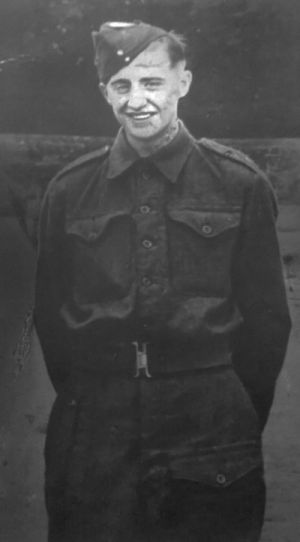 Private A.H.W. Harrison, who died on 8 Mai 1945 in a traffic accident in Amsterdam. Source: Foundation Memorial Dam Victims.
Private A.H.W. Harrison, who died on 8 Mai 1945 in a traffic accident in Amsterdam. Source: Foundation Memorial Dam Victims.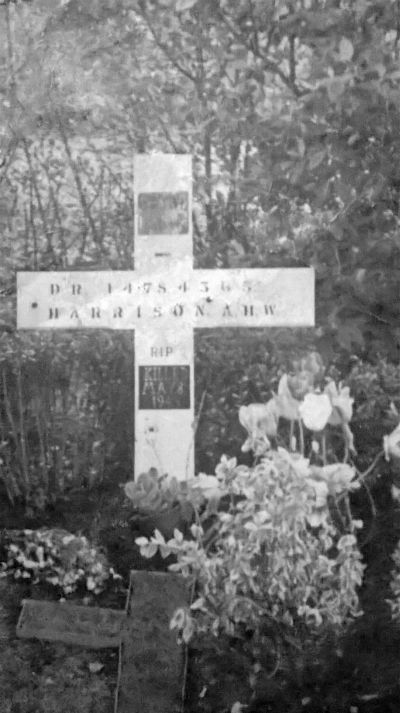 Grave of Harrison on the Buitenveldert cemetery in Amsterdam. Source: Foundation Memorial Dam Victims.
Grave of Harrison on the Buitenveldert cemetery in Amsterdam. Source: Foundation Memorial Dam Victims.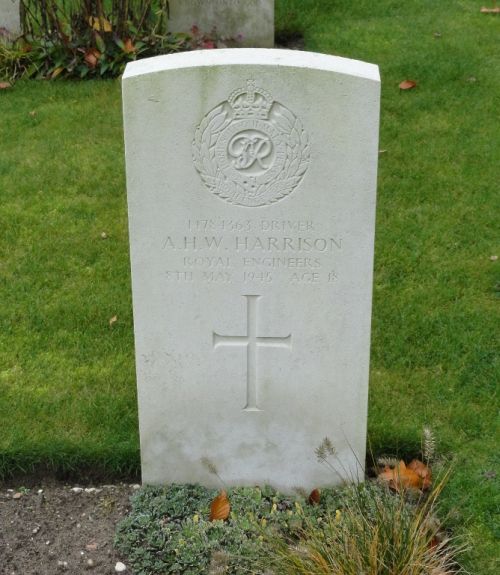 Harrison was reburied on the Jonkerbos War Cemetery in Nijmegen. Source: Foundation Memorial Dam Victims.
Harrison was reburied on the Jonkerbos War Cemetery in Nijmegen. Source: Foundation Memorial Dam Victims.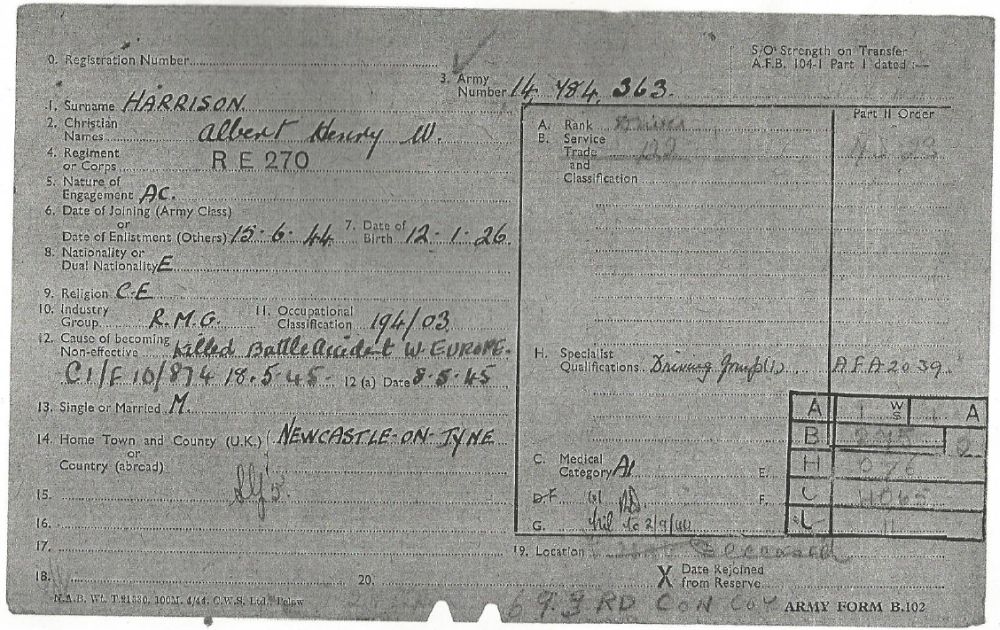 Register form for the army of Harrison with the incorrect birthdate. Source: Foundation Memorial Dam Victims.
Register form for the army of Harrison with the incorrect birthdate. Source: Foundation Memorial Dam Victims.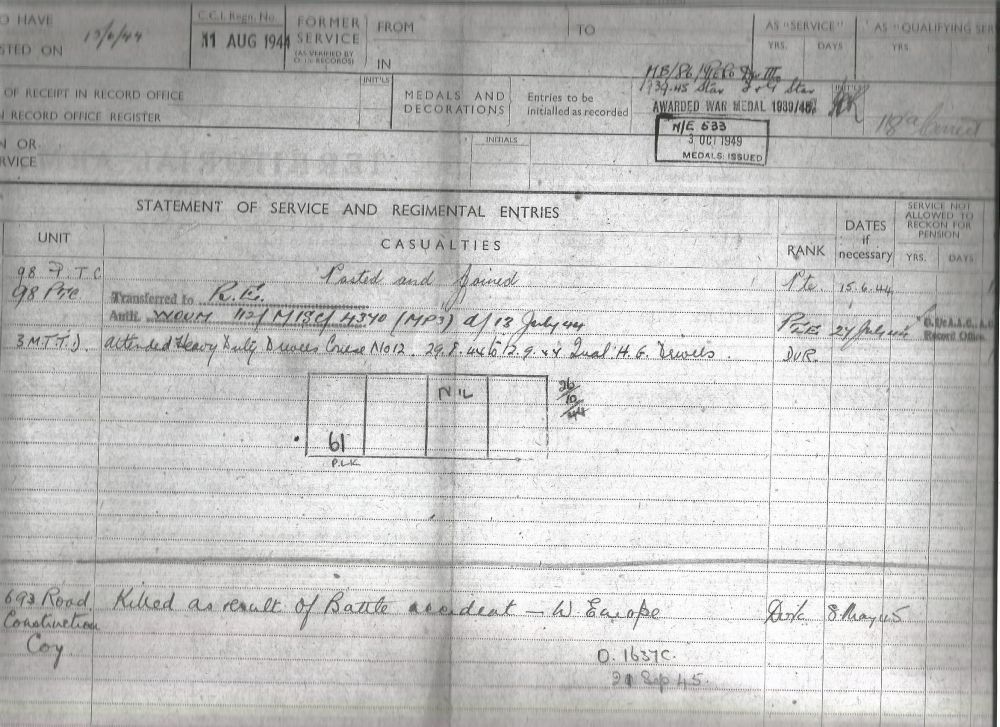 Page from the record of service paper of Harrison on which his death is mentioned. Source: Foundation Memorial Dam Victims.
Page from the record of service paper of Harrison on which his death is mentioned. Source: Foundation Memorial Dam Victims.Information
- Published by:
- Ludmilla van Santen
- Published on:
- 03-05-2015
- Last edit on:
- 26-12-2018
- Feedback?
- Send it!
Sources
This document from the Amsterdam City Archives was made available by Foundation Memorial 2015 for Dam victims.



